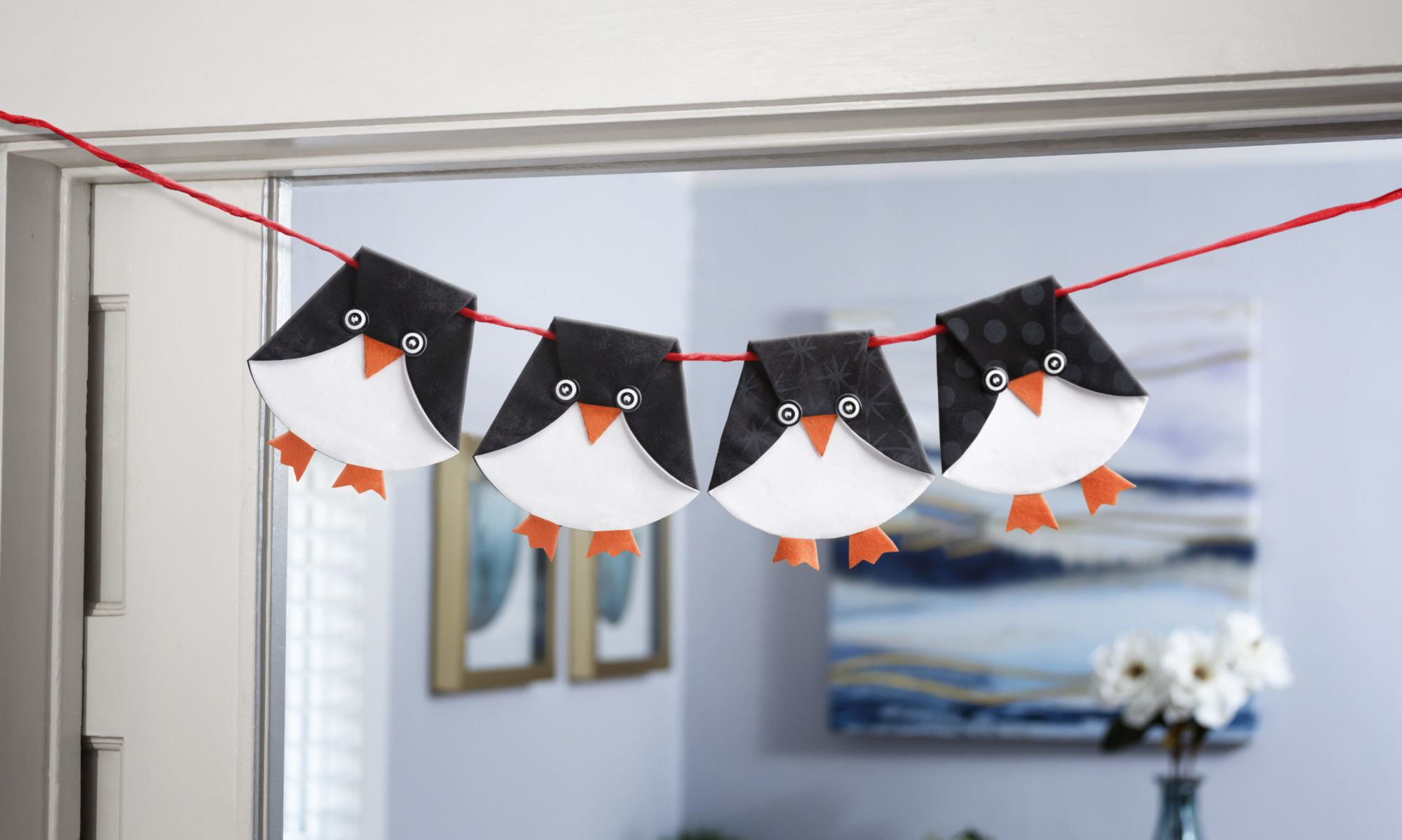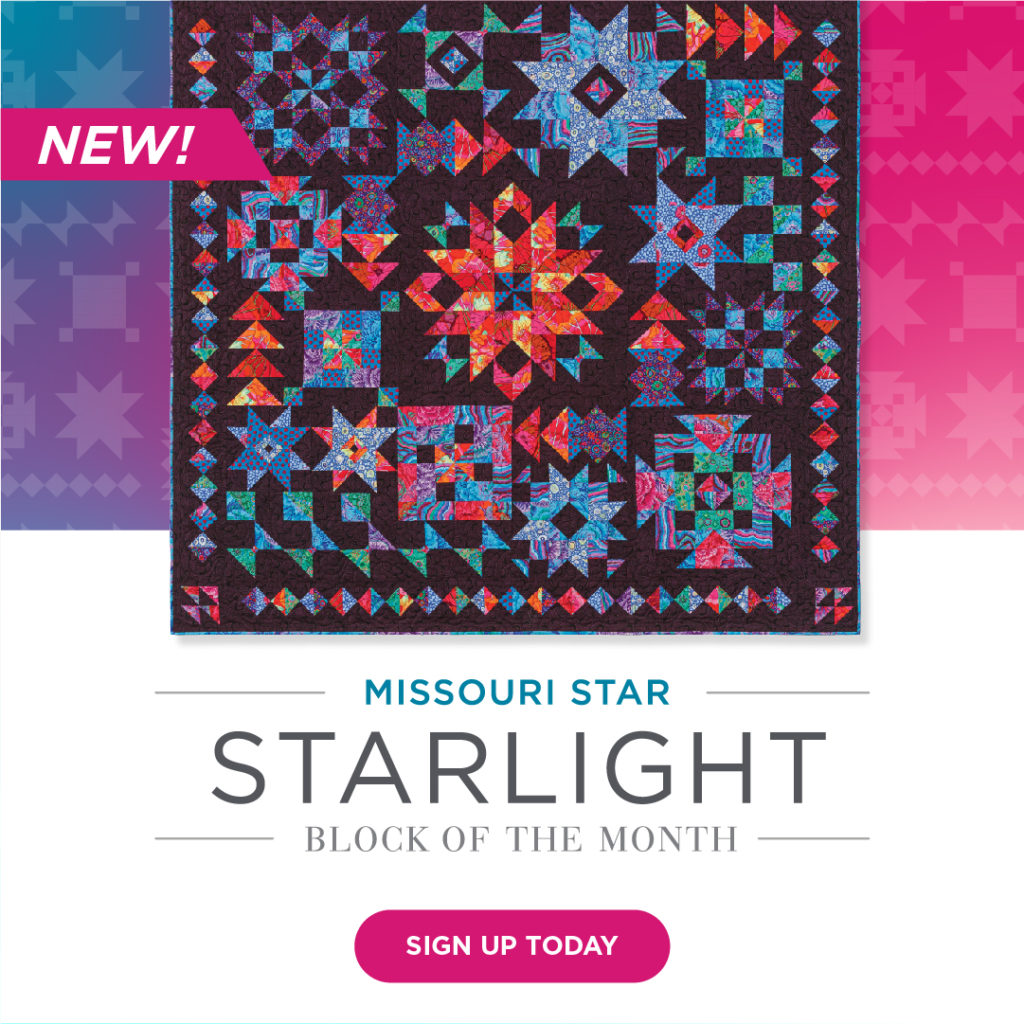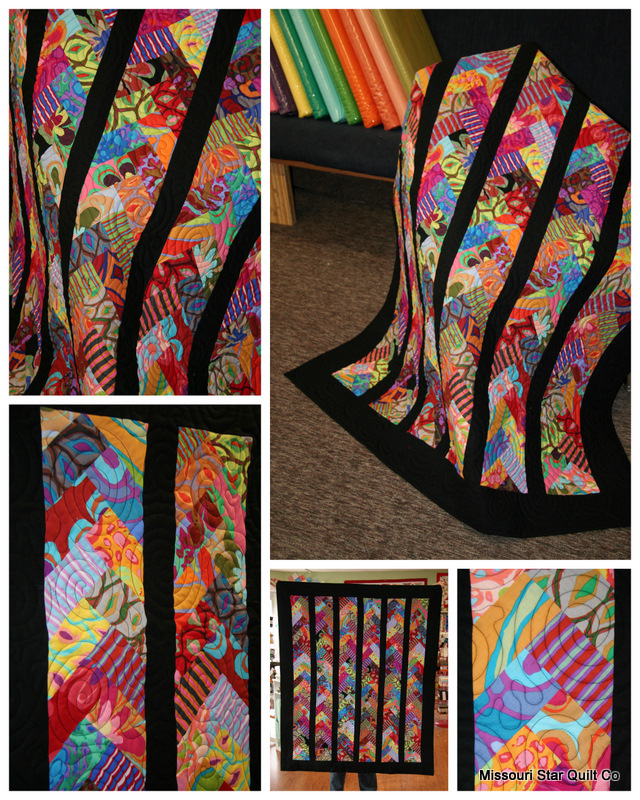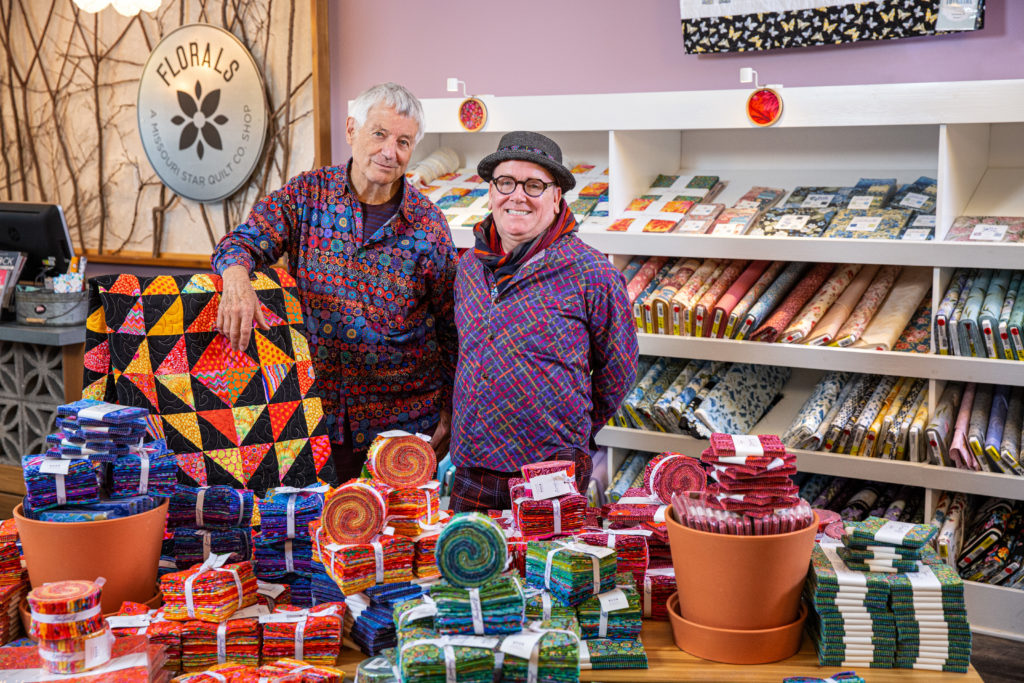
Color is king when Kaffe Fassett comes to town! In 2019, we were thrilled to host the world-renowned color guru himself at a workshop and a lecture highlighting his latest projects. It was a feast for the eyes to see the Kaffe Fassett Collective’s designs up close and personal and our fabulous social media manager took a moment to sit down with Kaffe and Brandon Mably to chat about the sources of their inspiration and how they are able to collaborate so seamlessly together. These two amazing guys spoke candidly about their personal influences, the joy of teaching and learning, and how they intend to spread a love of color throughout the world!
You’ve been designing for decades. What eras have called to you the most? And maybe the least?
Kaffe: I would say, probably the most influential in my life was the “hippy” times. You know, I arrived in England in 1964, when the Beatles were just bursting onto the world. And so they encouraged us all to go down to the flea markets and vintage shops and buy wild doorman’s uniforms and make our clothes out of Indian bedspreads and god knows what. You know, there was a freedom of fashion and so forth, so that was an incredible time. I would say that’s probably the most influential event, that freed me up to just make myself up, reinvent myself.
Are there any eras that didn’t provide that inspiration?
Kaffe: I didn’t like when I went through the 50s, because I felt it was very stodgy and conservative. Because, you know, if you grew your hair more than a quarter of an inch longer than everyone else, if you met someone they’d say, “Why don’t you get a haircut? What’s wrong with you?” It was very annoying. You couldn’t be yourself. And that’s why I suppose that hippy time was so important because you could totally be yourself. But I look back at it now and I realize there was a lot of color … all the sort of pastel colors. I mean, it’s interesting when you see a revival of that time that they don’t get the color right. They don’t get enough pink and duck egg blue, all those wonderful high colors; the girls in canary yellow, twinsets and pearls, scarves, and their big, flowing skirts, all that stuff, it was interesting. The thing is, those poor girls, their hair had to be absolutely perfect! If it was in a bob it had to curl under, not a hair out of place, it was very plastic. So, there was a lot of stuff I didn’t like about that time.
And Brandon, how about you?
Brandon: I’m not old enough to have opinions about that. You know, for me, if it doesn’t move fast enough, I’ll grab it. I’m looking for a play on color and pattern and rhythm, and because Kaffe is more into Rococo and brocade and flowers, and I’m more about the repetition of markings, it could be chewing gum stuck to the pavement, it could be a zebra pattern, you know it’s what’s going to make dance and movement and pattern, and they all feed my imagination, but it’s never one thing. One thing will lead to another thing, so it’s never a direct take.
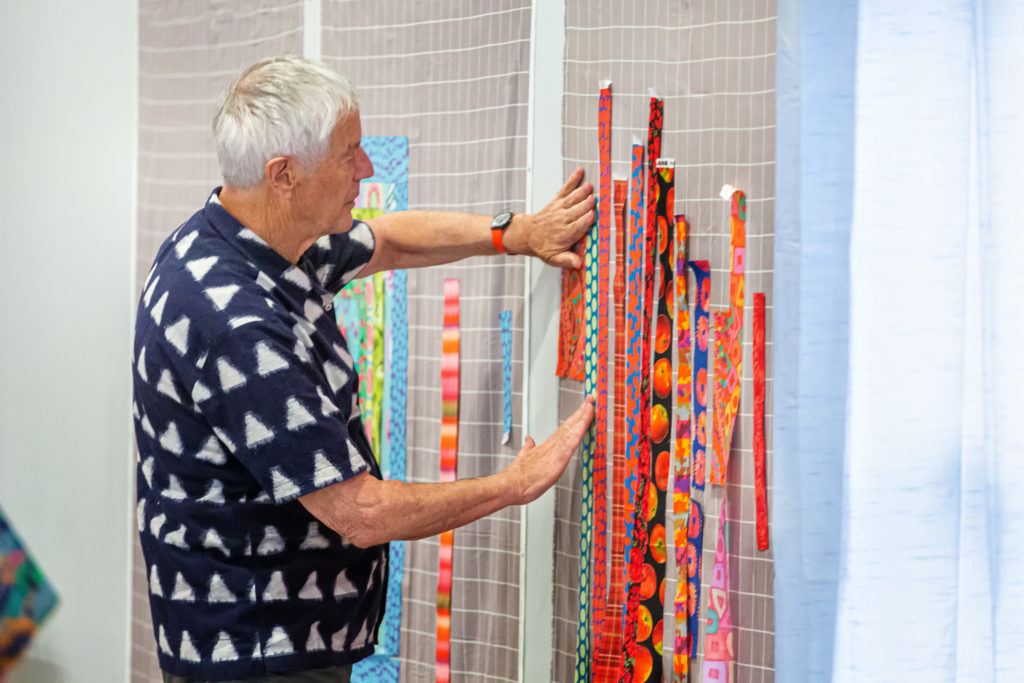
How do you see color evolving?
Brandon: We’re changing. Because in the past we were working with a lot of saturated color, but now you’ll see the fabrics coming out from ourselves have a little bit more edge and a little bit more contrast so when you cut up the fabrics, they give you a little bit more flicker, a little bit more play, rather than being more of a saturation. You will still have that color saturation, but it’s different, and also the patterns and structures that we’ve been inspired by having a little bit more contrast rather than a dense pattern. So, we’re changing all the time and we’re learning from our workshops, other people in our classes inspire us.
What insights have you garnered from people who have taken your classes?
Kaffe: Use of black and white is the strongest thing. Just people doing wonderful, contrasting things ‘cause that never used to be part of my vocabulary so much. I think what I’m trying to do always is to get clearer. I see a lot of my fans will take all of my big flower fabrics and Phillip’s big flower fabrics and put them together and end up with something very mushy, kind of chop suey. And so I try to get more clear and a little bit more definition in my pieces so you can actually see the structure. So, I suppose that’s what’s come out of the classes, really.
Is there a benefit then from using precuts where the collection is completely packaged in one?
Kaffe: It would never occur to me to pick up a package of something and try to make it work. One of the things that we do in our workshops is have people have a huge variety of fabrics to choose from and then sort out the ones that are disturbing the peace as it were, not making the color glow. It’s very difficult to do that if you’re very limited by somebody else’s choice of fabrics you should use. But, you can take anything and make it work.
Brandon: But the prepacks are fantastic for those who are a little bit intimidated by making a choice in so much color and pattern that they’re not used to.
Kaffe: Anything that gets people started, gets you going, is fine with us. Then they can come to one of our classes and refine the whole thing.
You’ve mentioned something about using blacks with the colors and how the white kind of drowns out the color of the fabric.
Kaffe: Well, I wasn’t saying using black, but I would use … I’ve just done a whole range of shot cottons that are quite subtle colors. Those kinds of colors go beautifully with the more florid, expressive colors of flowers.
Brandon: I mean, every color has its place, but white steals the intention from color. Black attracts and pushes color forward, more than what you possibly needed unless you control a color. Lots of shades of whites can be beautiful, lots of shades of darker tones and blacks can be beautiful, but put those with neon colors, they’re gonna fight.
Kaffe: What white does is overshadow the color and, very often, rather than helping it to glow. And that’s what our whole thing, what our workshops are trying to get people to do is to make color be released and have its full potential. Billions of people in the world think white is a wonderful background for fabrics and we just are there to differ with them.
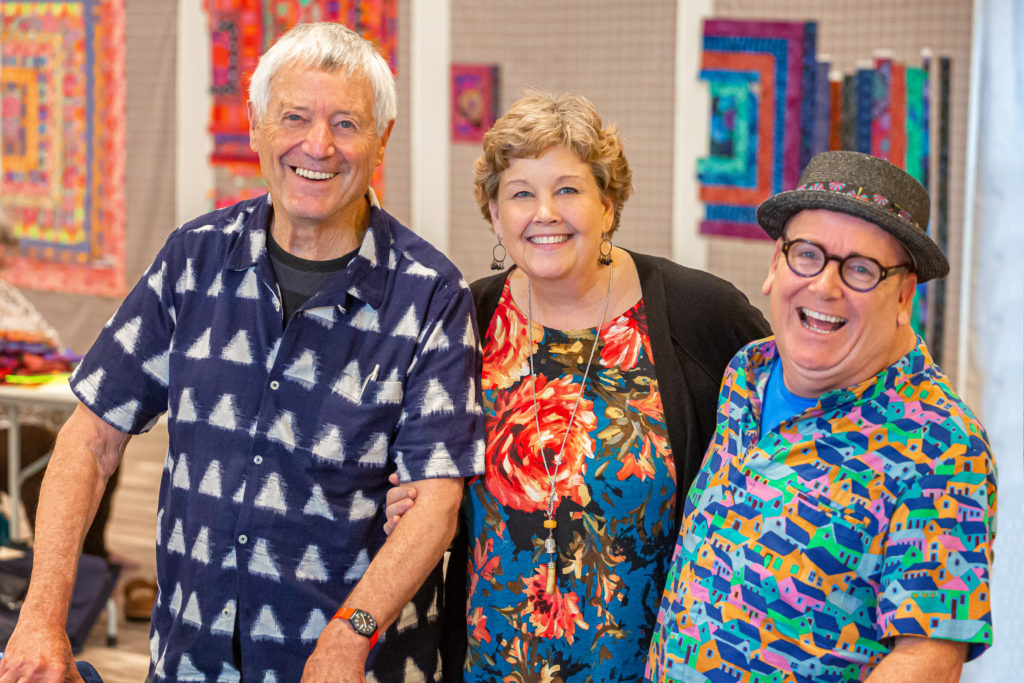
That’s a great experiment though too, right?
Kaffe: You know something, I think you learn as much from what doesn’t work. Okay, now I see that. I never need to do that. I can see that that blend doesn’t work. It doesn’t do anything for the color. So, good. Now I’ve seen all those quilts. I can just go and do something different.
Brandon: We will never stop learning because color is so unpredictable. And it’s not about a theory or a color wheel or a process. Neither of us had any education about color. But what we’ve done is we have a level of confidence to allow ourselves to make mistakes and learn from that.
And what would you say to people who maybe struggle with allowing themselves to make mistakes?
Kaffe: There’s a great fear of getting color wrong. Our whole lives are experimenting and playing with color. We got past that fear.
Brandon: People judge themselves too harshly. One of the big lessons that Kaffe taught me at the very beginning is “have a go. Just try. Keep on trying.” But also if you don’t like it, guaranteed somebody else will. So stop thinking you’re making it for a particular reason. Just enjoy the process and see what comes out of it.
You both experiment with art and creating in different mediums, how do you think that helps you when it comes to designing fabric and working with textiles?
Kaffe: Everything we do is experimenting with color. If you make a bouquet of flowers, if you throw cushions onto a couch, if you choose wallpaper, or whatever. Basically, what we’re doing is making mosaics, we’re making rag rugs, we’re designing fabrics, we’re making quilts, we’re doing knitwear, we’re doing needlepoint—it’s all playing with color. And then we have exhibitions which make a great kaleidoscope of groups of colors, so that that really has a dramatic, theatrical impact to the people that come to that museum and see our shows.
Brandon: It’s an incredible journey what we’re on because we basically hand paint all our artwork, nothing is done on the computer, then it goes off to Charlotte, North Carolina, then it’s sent out to Korea and it comes back in fabric form. And then we get to cut it up and then rearrange that on our design wall into a large scale arrangement and that gets sewn, instructions are written, and then we go out to a lavish location and photograph that. And we choose aesthetic locations that the whole thing has a harmony.
Kaffe: The location actually reflects the color that’s in the quilt.
Brandon: So we’re completely controlling the look. And there’s play, play, play, play, and we never have a plan, until even the photoshoot, we’re living by the seat of our pants. That’s why I have no hair! I used to be a long, blonde, curly-haired, Tarzan-looking, gorgeous George. But look at me now!
With the books, like Quilts in America and Quilts in the Cotswolds, were those unplanned?
Brandon: We go and go a 2-day recce (reconnaissance). So, we access a place. And then we go back. We don’t know what the weather is going to be like. We know what time of year it is. We haven’t got the quilts made. They’re still being given birth to until the week we fly away.
Kaffe: I mean so much so that one of our locations was a fabulous park full of incredible tulips in Holland and we said to them, “Can we come and photograph here tomorrow?” and they said, “Absolutely!” But overnight they cut every flower down in the entire park. And you forget to ask questions like, “ You’re not going to cut your flowers down, are you?” They thought we were coming to photograph black earth, I guess. Because that’s what we had. So we said, “What have you done with the flowers?” They said, “They’re dumped out in the back.” So we took the girls out and threw the models down on top of dead flowers. And that was our shoot. That’s how unplanned it is.
Do you design separately and then come together?
Brandon: Yeah. I mean, we’re in the same space. We’re just in different rooms.
Kaffe: We encourage each other in our designs.
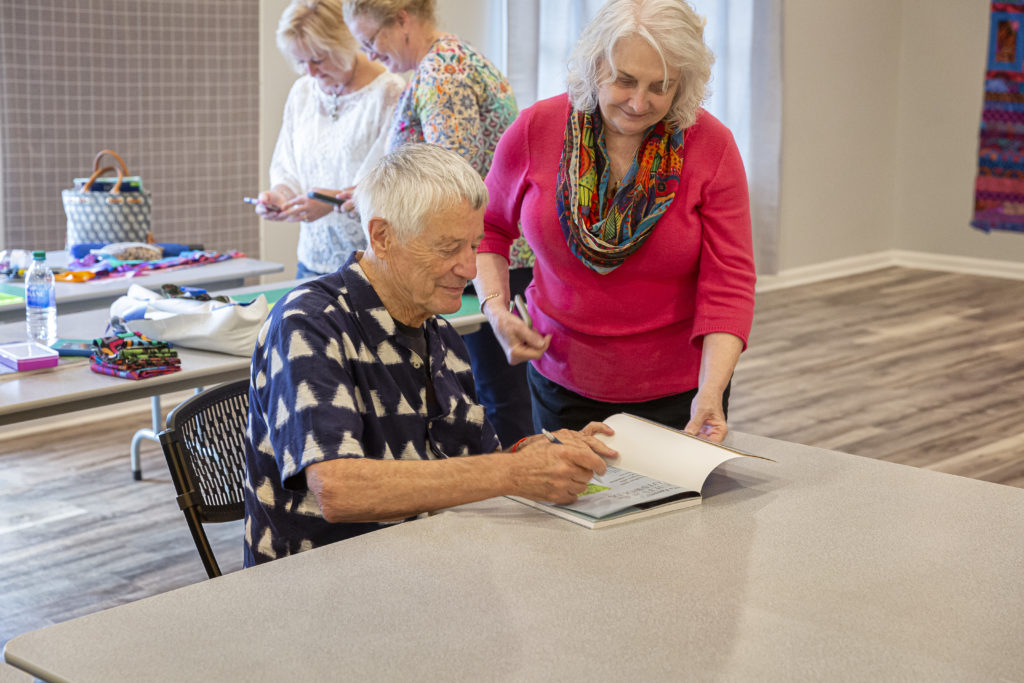
Switching gears a little bit, about how long have you followed Jenny and the Missouri Star story?
Kaffe: Well, I heard about this story. They said this woman in the middle of America has become the businesswoman of the year and then this mythological thing of how it all came about. You know, it’s just amazing. It’s an extraordinary story. Is somebody writing her story?
Social Media Manager: We’ve documented it a few times, but to sit down with her and create a book like yours, we should totally do that.
Kaffe: Totally! Because that’s a great, great story. We came here very curious to see the spot where all this happened.
Brandon: We heard about it at the Houston Quilt Market, it was like a virus, everybody was talking about it, and how this online, educational website was also selling and it was just bringing more interest to the world and how it was kind of encouraging more people. And then we started to hear when they were taking over a town and introducing shops and we didn’t think it would be as together as it was. We thought there would be a shop here and a shop there, you know. It’s not always you can buy a high street (like a main street), it just doesn’t seem possible. So, when we were brought up from the airport, we were driving, driving, driving, we were thinking, where the heck are we going. And then we saw a big, billboard sign saying “Quilt Town” and we were like, hey!
Your designs and your creations resonate with people from old to young, beginning to advanced, why do you think that is?
Kaffe: First of all, there is a big nostalgic element to the way I design. I look at the world of decorative arts: old carpets, old wallpaper, old things, so there’s a big nostalgic element to that. Brandon’s far too young to have any nostalgia, so he produces these very funky, modern, kind of primitive, exciting, geometric designs that work very well with our, Phillip’s and mine, kind of very floral, painterly fabrics. So, there’s a great combination, but I would say that more than anything else, that it’s the color that has grabbed people. For some reason, the quilt world was so enveloped in past history that all the color was browned down. So, we had a lot of browns, ochres, you know, pale creams, and everything kind of had milk in it or earth in it. And I wasn’t into earthy colors. To me, when I travel the world, I see Gypsy caravans, and I’m very attracted to circuses and fun fairs, and, you know, vulgar, crazy bright colors. So, I love all that and I put that into my fabrics. And Brandon does too. His color is vibrant.
Anything you would like to add?
Brandon: Absolutely. I totally agree. I think a big part of why our audience is wide is that it’s a collaboration. There’s three artists involved and Phillip is an extraordinary painter, but it’s Kaffe’s colors that are what people see. It’s very rare that Phillip’s actual, original artwork is seen by the public, and colors, because he doesn’t do colorways, and then Kaffe puts the magic into those. And then he does his own colors. And I kind of give them a little bit of separation or space. They call me “zany”—I should change my name. And yeah that appeals to those who want to be a little bit more daring. And there are those who, if they can’t cope with my wacky contemporary, they can lean more towards Kaffe and Phillip. And so it’s a very good blend.
Where do you see quilting and creating evolving in the next 5, 10 years?
Kaffe: As we have taught over the years and traveled, we see people improving unbelievably, so that our workshops now, there’s nobody that falls through the net. Nobody that doesn’t actually make it to the end of the project. They may have a fragment of something, but they’ve got something up there that tells us the color they’re doing. And so, I would see improvement, improvement, and that people seem to be getting much more our message about how color can be vibrant and sexy, rather than contrasting and edgy. You know, it’s like the formulas of white backgrounds and contrast. When I first came into the industry, this woman said to me, “You have to understand about patchwork, if you’re going to get into it. There’s three elements: there’s the light and the dark and the medium, and you have to have those elements always in a quilt.” And so there are these formulas that people go by, rather than, what makes that color suddenly come alive? So, I would say it’s improving and I have great hopes for the future because every year that we go out, every set of workshops we do, they get better.
Brandon: I believe, I think we’re in a world of education. Missouri Star is a huge part of that by Jenny giving her tutorials, and I don’t think a shop can exist without giving workshops because what you’re doing is, you’re encouraging your customers to be a little bit more adventurous, try something new and daring and step out of your comfort zone. So you feel a little bit more open. So yeah, I think it’s our responsibility to get people to just try and, not just scare them, but try to get them to be a little bit more daring.
We’re so proud to announce that our Missouri Star Starlight Block of the Month quilt will feature fabrics from the Kaffe Fassett Collective prints. Click below to learn more about this exciting new BOM and get stitching with the master of color himself!
